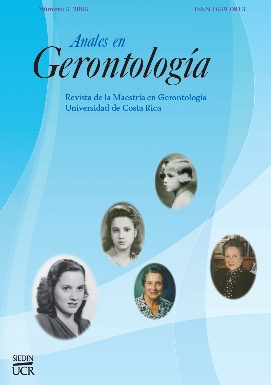Abstract
In this article, the discoveries of a qualitative study performed with 22 elderly persons that belong to the group “Joyful Aging” of the community of Orosi, Cartago, are described. The objective of this investigation was to establish alternatives for personal developing and leisure activities for this group of people. The recompilation of information was completed by means of active observation and semi-structured interviews, as well as prepared group activities. The project included educational sessions based on requested topics by elderly persons, leisure activi- ties and handicrafts. Participative techniques, such as: readings, group discussions and forums, among others, were used. Among the resulting conclusions, the taking over of the project and commitment of the participants who instead of being just simple receptors became program creators, were highlighted. The elderly persons decided and analyzed for themselves the existent group necessities as well as their possibilities. The results show that the group process that was generated produced taking over and raised new interests in every participant. This, at the same time, improved the commitment and productivity of the group itself.References
Argyle, M. (1987). Psicología de la Felicidad.Madrid: Alianza Editorial Argentina.
“Carta de Ottawa para la promoción de la salud” (1988). En: Salud para todos. Suplemento. Febrero.
De Castro, A. (1990). La tercera edad, tiempo de ocio y cultura. Madrid: Narcea.
Kaplan, M. (1975) Leisure: Theory and policy. New York: John Wiley & Sons.Kleiber,
D. (1991). Motivational reorienta-tion in adulthood and the resource of leisure.Advances in Motivation and Achievement. New York: John Wiley & Sons.
Lalonde. (1974). Informe general. Canadá.
Molina, J. (2003). Actividad, la clave del éxito para afrontar la vejez. Universidad de Chile. Escuela de Medicina.
Muñoz, Y. (s.f.). “En total movimiento”. En: La Nación. San José. Costa Rica.
Munné, F. (1995). Psicosociología del tiempo libre. México: Trillas.
Mustieles, D. (1997). Sistematización para la práctica en grupos. México:Editorial Lumen. Neulinger, J. (1974). The psychology of leisure. Springfield: C.C. Thomas Publisher.
Organización Panamericana de la Salud (1978). Declaración de Alma-Ata. Ginebra, OMS.
Pedersen, O. (1985). Calidad de vida y tiempo de ocio. E.U.A. Traducido por Héctor Lorna. México.
Siggerist, L. (1950). Promoción de la salud. EE.UU.: Journal of Leisure Research.
Vargas, K. (2005). Fortaleciendo la organización para el empoderamiento y la autonomía del grupo Ollita Llena. Tesis para optar por el gradoaca-démico de Magíster Scientiae en Gerontología. Universidad de Costa Rica. San José.
Veblen, T. (1899). The theory of the leisure class (2ª Edic. 1953). New York: New American Library.

